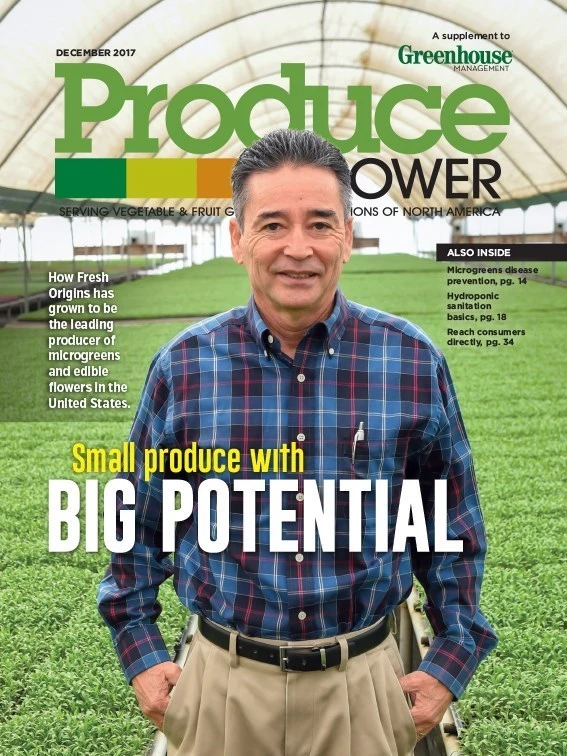

If you’re a wholesale produce grower, you might wonder if marketing direct to consumers is worth your time and money. The answer to that question depends on your sales goals and your niche market, but it is most likely yes. While you may feel direct to consumer (D2C) marketing or sales aren’t a part of your job as a wholesale grower, it’s important to remember that both you and your retailer share the same end-customer: sales of your product don’t stop with your retailer. Ignore D2C and you could be missing a big opportunity.
When it comes down to it, your brand and your product are your responsibilities. You’ve invested a lot of cash, blood, sweat and at least a few tears into it. Putting the fate of its (your) success in the hands of someone else seems unthinkable. Due to the internet and social media, consumers today expect to have a lot of information available to them about all products they purchase, as well as an engaged relationship with the brand. Food is no different. You just can’t count on retailers to promote your brand for you, or engage with consumers on your behalf, as they might have in the past. As a grower, your retailers now expect you to help them attract customers and add value to your product with enhanced packaging, labeling and good prices; and public outreach through marketing.
Marketing D2C gives you the opportunity to increase and improve brand and product familiarity along all parts of the sales chain. If you aren’t tailoring your produce, packaging, and marketing efforts to better suit the end-user’s wants and needs, you’ll make the retailer’s job that much harder. When their sales suffer, so do yours.
Marketing to consumers might be even more important to you if you’ve been phased out by a mass merchant you once relied heavily upon for bulk sales. You may have no choice but to find savvy new ways to capture new sales through marketing directly to the consumer.
So, where and how do you market to the consumer? Deciding on the best marketing and advertising channels depends on who you’re trying to communicate with. As always, good marketing requires good customer targeting. As a wholesale producer, it’s probable that you have several ideal customer profiles you need to flesh out. Your ideal broker/buyer, your ideal retailer/restaurant, and your ideal end consumer. While the common theme that should thread your marketing tactics together will of course be the benefits to the end user, your collateral, communication, engagement, and education for each target will need to be customized based on their needs, wants and what they value.

If you’ve spent time and money developing great branding and packaging for your produce, then you should commit to a culture of education. A content-heavy website that provides consumers with inspiration and instructions on how to use your produce, as well as an engaging social media presence, should be a top priority.
There’s also marketing communications to the end customer, which includes a rich online presence, social media marketing, PR, direct mail, and paid advertising; and then there are direct sales to consumers via in-person events, retail pop-ups, farmer’s markets, co-ops, and the like. The latter will require more time, effort, and money for you to pull off. And, your retailers might not like you selling both to them and direct to consumers. You’ll have to assess overlap in your market to make sure you don’t alienate key wholesale customers. If you can keep your retailers or other wholesale buyers supplied and happy, while at the same time generating some direct revenue from consumers, that’s a win/win.
What do you do if you get pushback from key wholesale buyers for marketing or selling direct? Remind them that boosting brand awareness for your products typically helps boost sales of your product at the retail level. Ask for cross-marketing opportunities with them so you can also promote their brand at the same time. Be sure to tag them in your social media posts and share their content.
Know that marketing and advertising efforts are real work and they require staffing and a budget, to back them up. Taking the reins of D2C marketing will affect your operating budget as you’ll need to develop a plan to help guide your efforts, and staff (or agencies) who can effectively communicate with consumers.
Ultimately, the marketplace is changing. Catering to D2C needs might not just be an opportunity at this point, but rather a requirement to thrive and remain relevant in the future.

Explore the December 2017 Issue
Check out more from this issue and find your next story to read.
Latest from Produce Grower
- The Growth Industry Episode 3: Across the Pond with Neville Stein
- PG CEA HERB Part 2: Analyzing basil nutrient disorders
- University of Evansville launches 'We Grow Aces!' to tackle food insecurity with anu, eko Solutions
- LettUs Grow, KG Systems partner on Advanced Aeroponics technology
- Find out what's in FMI's Power of Produce 2025 report
- The Growth Industry Episode 2: Emily Showalter on how Willoway Nurseries transformed its business
- 80 Acres Farms expands to Georgia, Texas and Colorado
- How BrightFarms quadrupled capacity in six months





